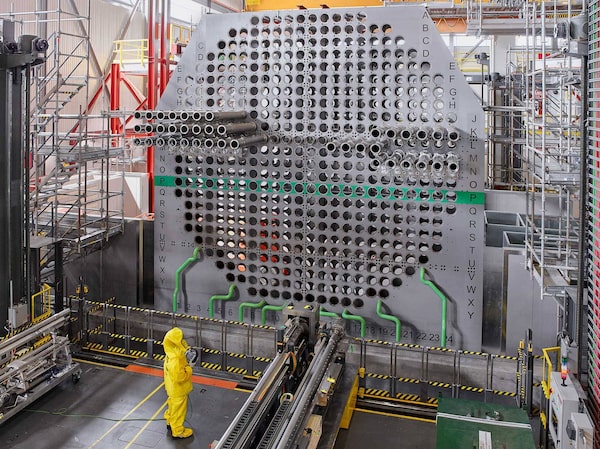
At the 65,000-square-foot training facility in Bowmanville, Ont., workers in radiation suits do drills in a mock-up of a Candu reactor to prepare for the actual overhaul in an undated photo.Philip Cheung
Jean Chrétien is a former prime minister of Canada. Mike Harris is a former premier of Ontario. Both serve as co-chairs of Canadians for CANDU, a campaign by AtkinsRéalis to promote Candu nuclear-reactor technology.
It can be disconcerting to think that the existence of Canada’s nuclear industry is owed in large part to pure happenstance. And yet, it is by blind luck that, after fleeing war-torn Europe, Russian-born scientist Lew Kowarski eventually landed on our shores. The National Research Council of Canada invited him and his team in 1942 to pursue the development of a new kind of nuclear reactor, one that would use heavy water as its regulator and natural, unenriched uranium as its fuel.
This unique reactor, which came to be known as Candu (Canadian Deuterium Uranium), stands as one of Canada’s most important technological innovations. Six decades after it was conceived, Candu remains the only nuclear power technology on the market that is both Canadian-made and Canadian-owned.
The advent of Canadian nuclear power provided for clean, reliable and abundant energy at a time when the country’s industrial base was growing rapidly. While the circumstances that brought Mr. Kowarski to Canada may have been unplanned, the subsequent and very successful deployment of Candu nuclear reactors at home, and later abroad, was the result of a concerted effort by government – one that we believe must be replicated today to meet the urgent need for secure, reliable, emission-free electricity.
Consider the urgent matter of addressing climate change. Nuclear technology can play a pivotal role in decarbonizing energy grids across the globe, as Canada and its international partners drive toward net-zero emissions.
Nuclear technology’s potential contribution to the fight against climate change is made all the more enticing by the impact it could have on our economy. More than 76,000 Canadians across a wide variety of professional and skilled trades fields are already employed in Canada’s nuclear industry. As Canada and other nations build new reactors in support of emissions reduction targets, there is immense potential for that number to grow – but only if we build Candu reactors.
Not all nuclear technologies are the same. Competing designs will not generate the same kind of economic opportunities for Canadians, because they will increasingly depend on employees, components and supply chains sourced from global markets. In contrast, a single Candu reactor can potentially support up to 60,000 jobs across the country.
Further, only Candu reactors use natural uranium mined in Canada. In contrast, alternatives developed outside of Canada use highly regulated and controlled enriched uranium. The use of natural uranium is a major advantage, considering the fact that Russia is the largest uranium enrichment supplier on the global market. Russian state-owned businesses provided no less than 35 per cent of global enrichment in 2021 and are projected to provide 30 per cent of global supply in 2035.
Candu is also the only nuclear technology that produces medical isotopes as byproducts. Isotopes help diagnose and treat disease, and are a vital lifesaving innovation, with 40 million nuclear medicine procedures performed each year. Just last month, Toronto-based Laurentis Energy Partners announced it would begin producing Yttrium-90 isotopes harvested from Ontario Power Generation’s Darlington Nuclear Generating Station to support cancer treatment in more than 30 countries. Medical isotopes are just one element in the nuclear research and innovation ecosystem centred around Candu technology.
A record number of countries now promote nuclear power’s role in energy security and achieving climate change mitigation targets. This was most recently exemplified by the pledge made by Canada alongside 23 other nations at COP28, the United Nations climate change conference. The countries agreed to triple nuclear energy capacity by 2050.
Yet very few countries have the capacity to build and maintain nuclear reactors. This represents a golden opportunity for Canada to capitalize on its unique nuclear expertise through the export of Candu reactors. Each unit sold could create up to 25,000 Canadian jobs, tapping into an existing, highly experienced Canadian supply chain of more than 200 companies.
We have an opportunity to assume a global leadership role that will support domestic and international efforts to fight climate change while nurturing Canada’s cutting-edge nuclear ecosystem.
We urge governments at all levels and of all stripes to seize on this occasion by choosing the deployment of homegrown Candu nuclear technology in the Canadian market, and aggressively marketing it to energy-starved partners across the planet.